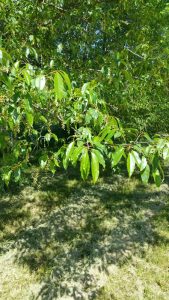Beware of black cherry toxicity; it’s weedy, too
Q. Was wondering if you could identify what species of tree this is from the photo? – RLW, Galveston, IN
A. This is black cherry, known botanically as Prunus serotina. This is a large, fast-growing native tree that can become quite weedy due to prolific fruit that is prized by birds and other wildlife. The foliage and twigs can be toxic when eaten by livestock and pets.
Q. Could you please tell me how to remove mold from some of the trees in our yard? Would the mold kill a tree? Or should we just let it be? – JZ, Columbus, Indiana
A. Difficult to answer specifically without having an accurate diagnosis of what you describe as “mold.” While there are several diseases that produce fungal growths on tree trunks and limbs, other growths may be secondary or benign. Examples include lichens, a greenish, scaly growth (https://www.ppdl.purdue.edu/PPDL/weeklypics/1-12-04.html) and various shelf fungi (https://www.ppdl.purdue.edu/PPDL/weeklypics/Weekly_Picture8-30-99.html).
Best bet is to get an accurate diagnosis. You can send or bring photos to your local county office of Purdue Extension. You’ll find contact information for your county at https://extension.purdue.edu/about/county-office.html. Or you can submit your digital images directly to the Purdue Plant and Pest Diagnostic Laboratory. See more info at www.ppdl.purdue.edu.
Q. I have two peach saplings and three apple saplings that I would like to plant within 15 feet of each other. Is there a specific arrangement I should plant the trees in? I was planning on a 15-foot square with an apple tree at two corners and the peach trees on the opposing corners. The third apple tree would be offset 15 feet from the square arrangement. Also, do apple trees need a different type of apple pollen to propagate? – BR, Borden, Indiana.
A. Are these saplings ones that you purchased as dwarf trees, or are they ones that you’ve grown from seed? Your proposed spacing could be too crowded for all but the most dwarf apple trees and will likely be too close for peach. Count on the trees maturing as wide as they are tall. Good air circulation and light penetration is critical for disease prevention, and you’ll need space to access for maintenance, harvest, etc.
If your saplings are dwarf trees, spacing at 20-25 feet apart would provide sufficient space yet be close enough to facilitate cross pollination. If these are seedling trees where mature height and fruiting quality will not be predictable, you’ll need considerably more space. And cross-pollination needs of seedling trees are not predictable.
Cross-pollination requirements vary by cultivar and species of fruit tree. Most cultivars of apple do need to be pollinized by a different but compatible cultivar in order to set fruit, though there are a few that are considered self-fruitful. Peaches do not require cross pollination.
For more information on home fruit growing, see the following resources:
Apple Cultivars for Indiana:
https://www.hort.purdue.edu/ext/HO-165.pdf
Pollination of Fruits and Nuts:
https://www.hort.purdue.edu/ext/HO-174.pdf
Purdue Fruit Gardening Resources:
https://hort.purdue.edu/ext/PurdueFruitResources.html
